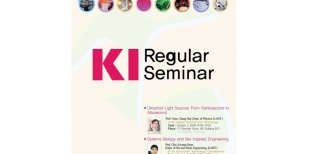KI Seminar will be held on November 11, 2008.
● Date and Time: Tuesday, November 11, 2008 16:00~17:30
● Place: Room 103, Creative Learning B/D
-Time: 16:00 ~ 16:30
-Speaker: Prof. Cho, Yong-Hoon (Dept. of Physics)
-Title: Quantum Dot-Based Nanophotonics and Nanobiotechnology: ‘Nano-Bio-Photonics’
-Abstract
Nano-bio-photonics, defined by the fusion of nanotechnology, photonics, and biology, is an emerging frontier providing challenges for fundamental research and opportunities for new technologies. It is a multidisciplinary field, creating many opportunities in physics, chemistry, material science, and biology, as well as in biomedical science and technology. Technological limits in various research subjects including near-field optical microscopy, photonic devices, and biosensing systems can be overcome by the use of the nano-bio-photonics fusion technology. This presentation provides the fundamentals and various photonics and biosensing applications involving the integration of nanotechnology, photonics, and biology. Some of latest results on functionalized nano-scale optical imaging, quantum and hybrid photonic devices, and nano-biochip applications based on semiconductor quantum dots, as well as the future prospects of this kind of research will be presented.
-Time: 16:30 ~ 17:00
-Speaker: Prof. Jeon, Seok Woo (Dept. of Materials Science & Engineering)
-Title: Opportunities from Carbon Based Nanoelectronic Materials and 3D Micro/Nano-structures
-Abstract
My research interests are exploring novel electronic and optical materials and employing those materials in real world applications.
Current materials of interest are carbon based nanoelectronic materials (i.e. CNT, graphene) and metamaterials in a broad sense (i.e. photonic crystal, functional porous structure), both of them are relatively new and have interesting material aspects. In this talk, I will introduce the emergence of those materials, the significance of material properties, and the difficulty of material preparation. And then, some of my recent work to utilize the properties of these materials and to prepare them fast at low cost will be presented.
-Time: 17:00 ~ 17:30
-Speaker: Prof. Kim, Bumjoon (Dept. of Chemical & Biomolecular Engineering)
-Title: Polymer coated nanoparticles: their positioning in and influence on block copolymer morphology
-Abstract
Polymers brushes grafted to the nanoparticle surface enable the precise positioning of particles within a block copolymer matrix by determining the compatibility of nanoparticles within a polymeric matrix and modifying the interfacial properties between polymers and inorganic nanoparticle. Short thiol terminated polystyrene (PS-SH), poly(2-vinylpyridine) (P2VP-SH) and PS-r-P2VP with the molecular weight (Mn) of 3 kg/mol were used to control the location of Au nanoparticles over PS-b-P2VP diblock copolymer template. We will discuss further the approach of varying the areal chain density (Σ) of PS-SH brushes on the PS coated particles, which utilizes the preferential wetting of one block of a copolymer (P2VP) on the Au substrate. Such favorable interaction provides the strong binding of Au particles to the PS/P2VP interface as Σ of PS chains on the Au particle decreases. We find that at Σabove a certain value, the nanoparticles are segregated to the center of the PS domains while below this value they are segregated to the interface. The transition Σ for PS-SH chains (Mn = 3.4 kg/mol) is 1.3 chains/nm2 but unexpectedly scales as Mn-0.55 as Mn is varied from 1.5 to 13 kg/mol. In addition, we will discuss changes in block copolymer morphology that occur as the nanoparticle volume fraction () is increased for nanoparticles that segregate to the domain center as well as those that segregate to the interface, the latter behaving as nanoparticle surfactants. Small of such surfactants added to lamellar diblock copolymers lead initially to a decrease in lamellar thickness, a consequence of decreasing interfacial tension, up to a critical value of beyond which the block copolymer adopts a bicontinuous morphology.



 The 7th KI Regular Seminar [2008-10-02]
The 7th KI Regular Seminar [2008-10-02]
 The 2008-3rd Forum for City of Tomorrow [2008-11-21]
The 2008-3rd Forum for City of Tomorrow [2008-11-21]